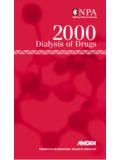Transcription of Slow, Low, Efficient, Daily Dialysis (SLEDD) in the ...
1 slow , Low, efficient , Daily Dialysis ( sledd ) in the Critically Ill PatientBy Pat Isaacs, MSN, CS, CNN, NPApril 24, 2006 slow , low, efficient , Daily Dialysis ( sledd ) is a form of renal replacement therapy for the critical slow continuous removal of solute and water tends to offer greater hemodynamic stability than aconventional hemodialysis treatment. sledd is a newer technique of renal replacement therapy thatutilizes conventional hemodialysis equipment, but with similar therapeutic goals as Continuous RenalReplacement Therapy (CRRT). sledd techniques combine the advantages of CRRT and Intermittent Hemodialysis (IHD) by usingconventional hemodialysis machines with blood flow rated (BFR) between 50-200 and dialysate flowrates (DSF) of 200-400.
2 Dialysis time varies anywhere from 6 to 12 hours or can be done possible variations and adaptations of blood flow, hemofiltration rate and duration of Dialysis time asa function of needs of the patient are practically unlimited, which makes sledd applicable to thecritically ill patient. Clinical trials comparing sledd to CRRT have failed to demonstrate a survivaldifference when adjusting for disease severity. The benefit is in being able to use one type of machine forany renal replacement therapy, instead of one machine for hemodialysis and a different machine economic evaluations have shown sledd to be less expensive than CRRT.
3 The main source ofsavings is in conventional Dialysis supplies, versus CRRT equipment supplies, bloodlines, kidneys anddialysate, versus industrially produced sterile substitution fluid. A hospital did a cost analysis of a CRRT treatment for an episode of acute renal failure, lasting an average of days with a replacement of theextracorporeal circuit every days. The cost of consumables (hemofilter, blood and fluid lines andreplacement fluid) per episode ( days) of acute renal failure was $1,614. The replacement fluid alonecost $ The equivalent cost for treatment with conventional Dialysis machines was $ ,assuming 10 Daily CRRT, when unable to use heparin, regional citrate (RC) used to be the anticoagulant of acts as an anticoagulant by binding the calcium.
4 RC anticoagulation requires the infusion ofcitrate into the arterial line. RC is costly, the set-up is complex and it requires additional staffinvolvement. Calcium needs to be replaced via the venous line and ionized calciums need to be closelyfollowed. With prolonged RC infusion, metabolic alkalosis and hypocalcaemia have been , a new acid bath/concentrate, matches very well with sledd as the renal replacement therapyof choice for the critically ill patient. Citrasate contains a small amount of citrate, which anti-coagulatesthe extracorporeal circuit. Citrasate causes no significant decline in calcium or magnesium.
5 The half-life of citrate is very short, which allows it to be quickly metabolized by the liver. Citrasate has alsobeen successfully used on liver transplant patients with no metabolization problems. Citrasate canprovide a better Dialysis treatment, reduced blood loss and a reduction in use of Citrasate in sledd or conventional hemodialysis treatments is an excellent alternative foran anticoagulant when heparin cannot be utilized; heparin-induced thrombocytopenia (HIT), bleedingrisks, trauma and impending/post surgery summary, sledd is an increasingly utilized renal replacement therapy that facilitates efficientdetoxification and has a favorable cardio-vascular tolerability profile for the critically ill patient.
6 Thetechnically simple, conventional, hemodialysis equipment is easier to operate, supplies are less expensiveand one has more flexibility in planning patient therapies.


